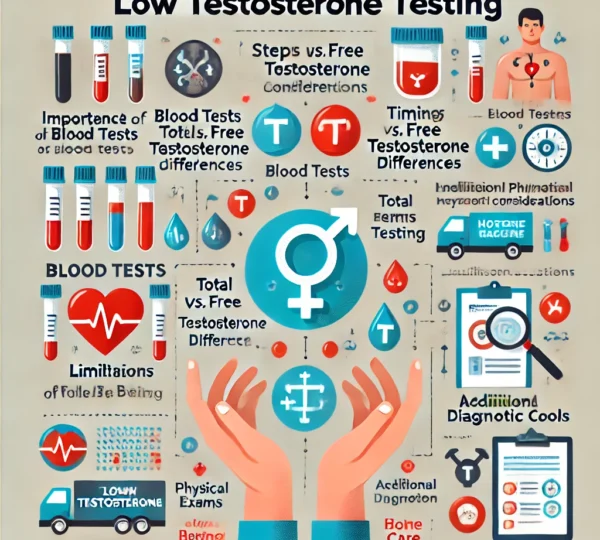Navigating Low Testosterone: Unveiling the Path to Accurate Testing
Introduction: What is Low Testosterone?
Testosterone is a crucial hormone for men, influencing many aspects of health, including muscle mass, bone density, mood, and sexual function. Low testosterone, or hypogonadism, occurs when the body doesn’t produce enough of this hormone. This condition can lead to a variety of symptoms, including fatigue, depression, and reduced libido. Understanding how to properly test for low testosterone is important for early detection and management.
Why Testing is Important
Testing for low testosterone is the first step in diagnosing the condition. Without accurate testing, it’s difficult to understand whether the symptoms you’re experiencing are caused by low testosterone or another issue. Blood tests are the most reliable method for determining testosterone levels. These tests can provide clear insights into whether your levels are within the normal range or whether they need further investigation.
Types of Testosterone Tests
There are two main types of testosterone tests that doctors typically use: total testosterone and free testosterone.
- Total Testosterone: This test measures the total amount of testosterone in your bloodstream, both bound and unbound to proteins. While it provides a broad understanding of your testosterone levels, it doesn’t give a clear picture of the testosterone that is available to your body’s cells.
- Free Testosterone: This test measures the amount of testosterone that is not bound to proteins. This “free” testosterone is the active form that can enter cells and influence your body’s functions. Many experts believe that this is the more critical test for understanding hormone levels and diagnosing low testosterone.
Factors That Affect Testosterone Levels
Testosterone levels fluctuate throughout the day, with the highest levels typically occurring in the morning. Several factors can influence your testosterone levels:
- Age: Testosterone naturally declines with age, especially after the age of 30. It’s normal for levels to decrease slowly over time.
- Medications: Certain medications, such as steroids and opioid pain relievers, can impact testosterone production.
- Health Conditions: Conditions like obesity, diabetes, and chronic illnesses can contribute to low testosterone.
- Sleep: Poor sleep or sleep apnea can also affect testosterone production.
Because of these variables, your doctor may recommend testing at different times or multiple tests to get a comprehensive understanding of your hormone levels.
Other Diagnostic Tools
While blood tests are the primary method for diagnosing low testosterone, your doctor may use additional diagnostic tools to gather a fuller picture:
- Physical Exam: A physical exam can help identify symptoms of low testosterone, such as reduced muscle mass or excess body fat.
- Semen Analysis: A semen analysis can help assess fertility and sperm count, as low testosterone often impacts reproductive health.
- Bone Density Tests: Low testosterone can lead to weakened bones, making a bone density test useful in diagnosing the condition and assessing any potential bone-related risks.
These tests, combined with your medical history and symptoms, will help your doctor make a well-informed diagnosis.
Treatment Options for Low Testosterone
If you’re diagnosed with low testosterone, there are several treatment options available to help restore hormone levels and alleviate symptoms. Some of the most common treatments include:
- Testosterone Replacement Therapy (TRT): TRT can be administered through injections, patches, gels, or pellets. This therapy helps restore testosterone levels to normal, improving symptoms such as fatigue, depression, and low libido.
- Lifestyle Changes: Incorporating regular exercise, a balanced diet, stress management, and quality sleep can help optimize testosterone levels.
- Medications: In some cases, your doctor may prescribe medications that stimulate your body to produce more testosterone naturally, or they may recommend other medications to address specific symptoms.
It’s essential to work closely with your healthcare provider to determine the best course of treatment for your individual needs.
The Importance of Monitoring Treatment
Once treatment begins, it’s crucial to monitor your testosterone levels regularly to ensure they are within the desired range. Your doctor will likely recommend follow-up tests to track your progress and adjust your treatment plan as needed.
Monitoring will also help assess any potential side effects of testosterone therapy, such as an increase in red blood cell count or changes in mood.
Conclusion: Working with Your Doctor
Low testosterone can significantly affect your quality of life, but with proper testing and treatment, you can manage the condition effectively. The journey toward diagnosis and treatment begins with a simple blood test and a conversation with your healthcare provider. Together, you can create a personalized treatment plan to restore balance and improve your overall well-being.
For More Information Click here



